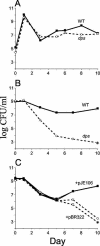Dps protects cells against multiple stresses during stationary phase
- PMID: 15205421
- PMCID: PMC421617
- DOI: 10.1128/JB.186.13.4192-4198.2004
Dps protects cells against multiple stresses during stationary phase
Abstract
Dps, the nonspecific DNA-binding protein from starved cells, is the most abundant protein in stationary-phase Escherichia coli. Dps homologs are found throughout the bacteria and in at least one archaeal species. Dps has been shown to protect cells from oxidative stress during exponential-phase growth. During stationary phase, Dps organizes the chromosome into a highly ordered, stable nucleoprotein complex called the biocrystal. We show here that Dps is required for long-term stationary-phase viability under competitive conditions and that dps mutants have altered lag phases compared to wild-type cells. We also show that during stationary phase Dps protects the cell not only from oxidative stress but also from UV and gamma irradiation, iron and copper toxicity, thermal stress, and acid and base shock. The protective roles of Dps are most likely achieved through a combination of functions associated with the protein-DNA binding and chromosome compaction, metal chelation, ferroxidase activity, and regulation of gene expression.
Figures








Similar articles
-
The DNA-Binding Protein from Starved Cells (Dps) Utilizes Dual Functions To Defend Cells against Multiple Stresses.J Bacteriol. 2015 Oct;197(19):3206-15. doi: 10.1128/JB.00475-15. Epub 2015 Jul 27. J Bacteriol. 2015. PMID: 26216848 Free PMC article.
-
The two Dps of Edwardsiella tarda are involved in resistance against oxidative stress and host infection.Fish Shellfish Immunol. 2011 Dec;31(6):985-92. doi: 10.1016/j.fsi.2011.08.018. Epub 2011 Sep 5. Fish Shellfish Immunol. 2011. PMID: 21907291
-
Requirement of Fur for the full induction of Dps expression in Salmonella enterica serovar typhimurium.J Microbiol Biotechnol. 2007 Sep;17(9):1452-9. J Microbiol Biotechnol. 2007. PMID: 18062222
-
Dps Is a Universally Conserved Dual-Action DNA-Binding and Ferritin Protein.J Bacteriol. 2022 May 17;204(5):e0003622. doi: 10.1128/jb.00036-22. Epub 2022 Apr 5. J Bacteriol. 2022. PMID: 35380871 Free PMC article. Review.
-
Structure, function and regulation of the DNA-binding protein Dps and its role in acid and oxidative stress resistance in Escherichia coli: a review.J Appl Microbiol. 2011 Feb;110(2):375-86. doi: 10.1111/j.1365-2672.2010.04890.x. Epub 2010 Dec 8. J Appl Microbiol. 2011. PMID: 21143355 Review.
Cited by
-
SpoT-mediated NapA upregulation promotes oxidative stress-induced Helicobacter pylori biofilm formation and confers multidrug resistance.Antimicrob Agents Chemother. 2023 May 1;65(5):e00152-21. doi: 10.1128/AAC.00152-21. Epub 2021 Mar 1. Antimicrob Agents Chemother. 2023. PMID: 33649116 Free PMC article.
-
Double-Strand Break Repair and Holliday Junction Processing Are Required for Chromosome Processing in Stationary-Phase Escherichia coli Cells.G3 (Bethesda). 2011 Nov;1(6):417-26. doi: 10.1534/g3.111.001057. Epub 2011 Nov 1. G3 (Bethesda). 2011. PMID: 22384352 Free PMC article.
-
Dps promotes survival of nontypeable Haemophilus influenzae in biofilm communities in vitro and resistance to clearance in vivo.Front Cell Infect Microbiol. 2012 May 3;2:58. doi: 10.3389/fcimb.2012.00058. eCollection 2012. Front Cell Infect Microbiol. 2012. PMID: 22919649 Free PMC article.
-
Gene expression changes throughout the life cycle allow a bacterial plant pathogen to persist in diverse environmental habitats.PLoS Pathog. 2023 Dec 19;19(12):e1011888. doi: 10.1371/journal.ppat.1011888. eCollection 2023 Dec. PLoS Pathog. 2023. PMID: 38113281 Free PMC article.
-
Decrypting the H-NS-dependent regulatory cascade of acid stress resistance in Escherichia coli.BMC Microbiol. 2010 Oct 29;10:273. doi: 10.1186/1471-2180-10-273. BMC Microbiol. 2010. PMID: 21034467 Free PMC article.
References
-
- Adamcik, J., V. Viglasky, F. Valle, M. Antalik, D. Podhradsky, and G. Dietler. 2002. Effect of bacteria growth temperature on the distribution of supercoiled DNA and its thermal stability. Electrophoresis 23:3300-3309. - PubMed
-
- Almiron, M., A. J. Link, D. Furlong, and R. Kolter. 1992. A novel DNA-binding protein with regulatory and protective roles in starved Escherichia coli. Genes Dev. 6:2646-2654. - PubMed
-
- Altuvia, S., M. Almiron, G. Huisman, R. Kolter, and G. Storz. 1994. The dps promoter is activated by OxyR during growth and by IHF and sigma S in stationary phase. Mol. Microbiol. 13:265-272. - PubMed
-
- Berger, S. L. 1999. Gene activation by histone and factor acetyltransferases. Curr. Opin. Cell Biol. 11:336-341. - PubMed
-
- Borenstein, L. A., J. D. Radolf, T. E. Fehniger, D. R. Blanco, J. N. Miller, and M. A. Lovett. 1988. Immunization of rabbits with recombinant Treponema pallidum surface antigen 4D alters the course of experimental syphilis. J. Immunol. 140:2415-2421. - PubMed
Publication types
MeSH terms
Substances
LinkOut - more resources
Full Text Sources
Molecular Biology Databases

